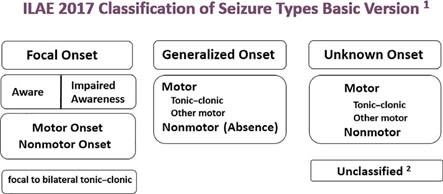ILAE 2017 Classification of Seizure Types Checklist
ILAE 2017 Classification of Seizure Types Checklist Form
In 2017, the ILAE approved an updated classification of seizure types and published the details in two companion articles in the League’s journal, Epilepsia. Please note that this is a classification of seizures and the classification of epilepsy is broader and appeared in a third article led by Professor Ingrid Sheffer.
- Fisher RS, Cross JH, French JA, Higurashi N, Hirsch E, Jansen FE, Lagae L, Moshé SL, Peltola J, Roulet Perez E, Scheffer IE, Zuberi SM. Operational classification of seizure types by the International League Against Epilepsy: Position Paper of the ILAE Commission for Classification and Terminology. Epilepsia, 58(4):522–530, 2017.
- Fisher RS, Cross JH, D’Souza CD, French JA, Haut SR, Higurashi N, Hirsch E, Jansen FE, Lagae L, Moshe SL, Peltola J, Roulet Perez ER, Scheffer IE, Schulze-Bonhage A, Somerville E, Sperling M, ia Yacubian EM, Zuberi SM. Instruction manual for the ILAE 2017 operational classification of seizure types. Epilepsia, 58(4):531–542, 2017.
Two related versions of seizure types were presented: a Basic Version expected to be of use for non-specialists and an Expanded Version for neurologists, Neurosurgeons, Electroencephalographers and those clinicians, researchers, pharmacologists, epidemiologists, surgeons, patients, or members of the public with special interest or expertise in epilepsy. The two charts below show the published classification.
ILAE 2017 Classification of Seizure Types Basic Version

ILAE 2017 Classification of Seizure Types Expanded Version

The ILAE 2017 Classification of Seizure Types Checklist Form converts the graphical tables to checklist format.
It retains the designation with descriptive words, rather than converting to numbers (e.g., Type II.b.3.). A seizure is classified as having focal onset if it originates (by clinical pattern or EEG localization) in one hemisphere of the brain and generalized if appearing apparently simultaneously in both hemispheres. A third category allow for the origin focality being unknown. Confidence level for focal versus generalized onset is set at 80%.
Examples of seizure type designations for the Basic Classification using this form are:
- Focal
- Focal aware motor
- Generalized absence
- Focal to bilateral tonic-clonic
- Superfluous words can be omitted, for example, generalized absence --> absence.
- Classification only continues as far as information is known.
- A focal impaired awareness seizure is present if awareness is impaired at any point during the seizure.
- A focal behavior arrest seizure must have behavior arrest through the entire seizure.
- With these exceptions, a seizure is classified according to its first (not its most prominent) manifestation.
Examples of seizure type designations for the Expanded Classification could include:
- Focal aware seizure
- Focal impaired awareness automatism seizure
- Typical absence seizure
- Focal myoclonic seizure
Subscribe to the ILAE Newsletter
To subscribe, please click on the button below.
Please send me information about ILAE activities and other
information of interest to the epilepsy community